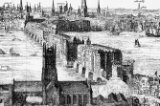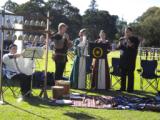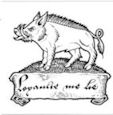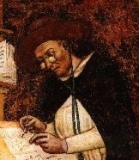Barbara Gaskell Denvil was born in England, grew up amongst artists and authors and started writing at a young age. She published numerous short stories and articles, and worked as an editor, book critic and reader for publishers and television companies. About 10 years ago she began writing medieval novels (mystery, romance, murder-adventure) set principally in 15th century England.
Her first medieval novel Satin Cinnabar is a historical crime adventure set in London during the last months of 1485 in the aftermath of the Battle of Bosworth. It is available for Amazon Kindle and all other ebook readers (Barnes & Noble, Kobo, Sony, ipad etc..)
Her new novel Sumerford’s Autumn is also set during the last years of the 15th century and will make major reference to the fate of both King Edward IV’s sons. It will be published for Kindle later this month or early in April.
Barbara also writes fantasy, though this tends to be more dark and adult. Her fantasy novel Fair Weather is set in medieval England around the early 1200s. There’s a fair chunk of historical content, but the basic plot is pure fantasy. It is also available for Amazon Kindle and from Smashwords in other formats.
Barbara’s novels are gripping and engrossing stories, real page turners, involving believable characters to carry the story along, while maintaining a high level of historical accuracy.
After reading Satin Cinnabar, we asked Barbara to tell us more about the medieval world she describes so masterfully in the novel. This is the first part of her article “Medieval Life”, parts 2 and 3 will follow in the coming days. Thank you, Barbara, for sharing this with us.
Don’t forget to visit Barbara’s blog.
———————————————————————————————————————————–
Baker’s apprentice? Cloistered priest? Wherryman or corvisor? Maidservant, brewster or laundry maid? Kennel boy or under-groom? Chandler or rakyer? Tanner, cooper or dyer’s assistant?
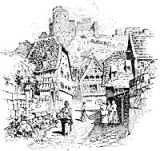 History, at least beyond the strictures of the schoolroom, holds a growing fascination for so many of us these days. Those gloriously ample arms, clothed in the luscious velvets of the past, reach out to embrace us and draw us back into the fascination of times long gone. There, in those cobbled alleyways wait mysteries and puzzles, horrors far more spine chilling than the simple enticing lurch of a modern roller coaster, and a whole catalogue of kings, queens, courtesans and wicked courtiers. Heroes and villains all – and what we find even more intriguing is that sometimes we cannot tell the difference nor be quite sure who was the hero – who the villain.
History, at least beyond the strictures of the schoolroom, holds a growing fascination for so many of us these days. Those gloriously ample arms, clothed in the luscious velvets of the past, reach out to embrace us and draw us back into the fascination of times long gone. There, in those cobbled alleyways wait mysteries and puzzles, horrors far more spine chilling than the simple enticing lurch of a modern roller coaster, and a whole catalogue of kings, queens, courtesans and wicked courtiers. Heroes and villains all – and what we find even more intriguing is that sometimes we cannot tell the difference nor be quite sure who was the hero – who the villain.
Indeed, many modern works of historical fiction are loosely based biographies, and these are invariably concerned with those great characters we have already heard about – the rich and famous – the royal and noble – the tyrants and the victims. But what of the rest? What of those teeming slums? The ordinary folk? The children, the housewives, the working men?
We authors of historical fiction usually feel obliged to research our chosen era to some extent and often in considerable detail, though some horrendous mistakes pop up even in the popular best sellers (after all, Shakespeare got away with it, but there are few of us who would dare compare ourselves to him!) but thankfully we are gradually moving away from the real myths and blunders of recent ignorance. Few of us now believe in the chastity belt, the Droite du Roi (in spite of Gibson’s Braveheart), the wholesale burning of witches in medieval England, or the knight in shining armour. (Sadly some of us still believe in the sins of the dastardly King Richard III – but that’s another story!)
So we have discarded the more obvious myths concerning medieval life, but many of us have no clear method of touching the everyday truths. Caught up in the deeds of kings, we do not understand the business of the ordinary man. Documentation is scarce, but thankfully enough survives and imagination does not need to stretch too far!
For a start the English weather, as always, played a part in medieval affairs. Storms wrecked Henry VII’s first attempt at an invasion whereas the Battle of Bosworth was fought on a glorious morning of bright August sunshine where the Tudor leaders used the direction of the sun to blind their adversaries’ aim. For hundreds of years the weather had been rather warmer than we are now accustomed to, encouraging the gutters and piles of manure to steam in the afternoon heat. But by the late 15th century the temperatures were cooling, and over the next two hundred years the winters turned fierce and the Little Ice Age was ushered in.
In the so called Middle Ages, human as well as animal manure was still used on the crops, though sometimes this was reasonably aged into a nice smelly slush. But the cities did not escape from these aromatic pleasures since human waste had only two methods of disposal. Firstly by the simple means of the chamber pot emptied from the door or window each morning, and secondly by the more subtle means of the medieval sewerage system. But nothing was that simple. The gutters usually consisted of a shallow central gulley running through the street; not the type of gutter which we recognise now – there were, after all, no pavements. Other refuse also collected in these gutters: chicken heads, sheep stomachs and all the bloody waste from the butchers’ stalls, rotten vegetables, and anything else discarded from the average household. Rain invariably washed out the gulleys, sluicing them down to the low ground where everything piled up for later disposal. There were, however, laws against the worst of these abuses, but they were frequently overlooked. There were also the rakers (or raykers) who were employed to rake up this noxious matter, and remove it – usually directly into the local river, stream or nearby lake. And the river, stream or lake was, of course, the only available water supply for most citizens. There were water carriers who would deliver to your door, and conduits and pumps – but even most of that came from whatever river was closest. No wonder folk drank beer instead.
The actual sewerage system consisted of septic tanks dug into the ground in convenient places. A large household contained at least one privy, being a hole (often in the middle of a wooden seat) and these emptied directly into the septic tank way below. Castle privies usually emptied into the moat by means of a pipe leading straight from one to the other. Many houses, often a whole street, would share the same septic tank, and also share the cost when this needed emptying out. Invariably the job was delayed by lack of funds or the disinclination to pay, but it was illegal to permit an overflowing septic tank. Which doesn’t mean it didn’t happen.
Poorer households did not usually own a privy. A chamber pot, or sometimes just the casual use of the street outside, was normal. There were also public privies in some places in the larger cities, invariably emptying directly into the river. Passers by could watch the results falling from the hut to the water. These public privies were only occasionally cleaned or repaired, the cubicles were often without doors, and some customers were known to tumble – along with their waste.
Urine was actually a useful commodity. Used in bleaching, tanning, glue making, medicine and general laundry duties, there were those who travelled the streets early each morning to collect the contents of chamber pots. You could sometimes sell your urine. What a useful trade.
A variety of animals roamed most city streets and these presumably added their own special smells. Dogs, both domesticated and feral, cats the same, wandered freely. But goats also broke free of their tethers and explored the local alleys, whilst chickens were particularly common. Keeping pigs and allowing them free run in the township was also illegal – but still occurred quite regularly. Small children (sometimes left to wander in poorer areas where neighbours were accustomed to keep a general watch) were often bitten by pigs, sometimes fatally. The swine of yesteryear were not friendly creatures.
But the stink of everyday life was not always as bad as it might seem. Today’s general belief that nobody washed in those days is quite inaccurate. Most people made a considerable effort to keep clean. There were large communal wash houses and these were much appreciated. They included a certain amount of cheerful prostitution, but they were principally used for the obvious purpose. People liked to keep clean and although a concept of modern hygiene was naturally nonexistent, cleanliness of both body and clothes was important to most. Many households made use of half barrels as baths, though naturally plumbing was not included. Cleanliness was therefore far easier for the rich, but was also practised whenever possible by the poor.
Picture of a medieval village © Florida Center for Instructional Technology, http://etc.usf.edu/clipart
Tags: Medieval Life
